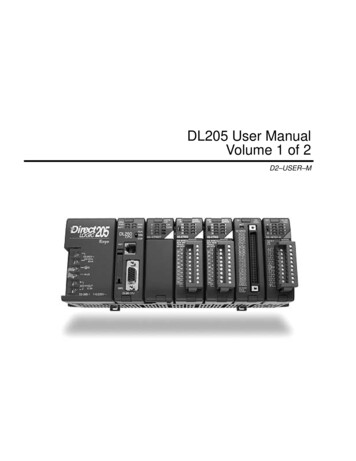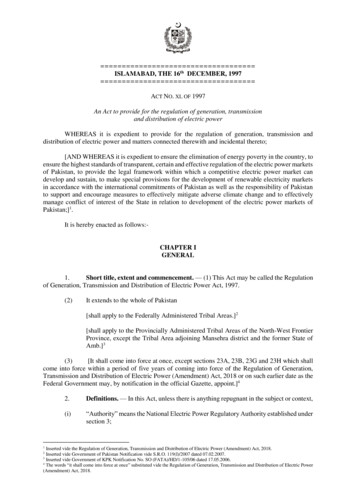
Transcription
User Manual of 2nd Generation Grid Tie Inverter with LimiterGrid Tie Inverter With Internal&External Limiter (GTIL)2016-3-1 All rights reserved1
Why we produced the GTI-L --- It is in response to the overwhelming clamor from ourcustomers for a product that can control the amount of power that the grid tie inverters(GTI) can generate so that the amount of excess power produced by the solar panelsarereduced to insignificant levels, if not eliminated --- because in some countries,the producer pays for the excess power it gives to the distribution grid. Thisis because the electric power meters (the one provided by the electricity provider in thearea) are not aware of the direction of power flow. In other words it only adds even ifpower is exported to the grid, thus, the consumers will be charged for power even if it isgiven to the grid, and this is the problemThis is the 2nd generation GTIL of Masspower.The first generation GTIL must be usedwith an additional limiter module,we also add an switch button to enable the invertereither can workat limit mode or at normal grid tie mode. With the 2nd generation GTIL,we integrated thelimit function inside the GTI-We call this internal limiter.In this way,No additional limitermodule is needed,reduced customer’s cost,more easier for installation.But in casecustomer install inverter far away from the main circuit breaker,we also enable the 2ndGTIL work with stand-alone limiter,we call this-external limiter.For sure,the inverter canwork under normal Grid tie-no limit mode,just set on the nice LCD and save your setting.
1. On-Grid System Using Standard Grid Tie Inverter1.1.1.2.The Grid Tie inverter converts DC power produced by Solar Panels to AC,connects to the grid and feed all of the power available from the panels to theAC load.All excess power that is not needed by the load is then exported to the Grid.1.3.If the Grid fails, then the Grid Tie Inverter will turn off. When the Grid comesback on line. The Grid Tie Inverter will again supply power to the load and anyexcess power is exported to the Grid again.1.4.If the Solar Panel is producing less power and the GTI cannot deliver all thepower needed by the load, then powerwill be supplemented by the Grid.1.5.Power Meters (Except smart meter) are not aware of the direction of Powerflow. The user then pays for the power exported and delivered by the Grid.
2.On-Grid System Using Grid Tie Inverter With Limiter (GTIL)2.1The Grid Tie Inverter with Limiter delivers only the power needed by the load andprevents delivering excess power hence avoids excess power in going back tothe Grid.2.2The heart of the Grid Tie Inverter with Limiter is the Limiter Module (LM). The LMcontinuously sampled the power needed by the load through the current sensorconnected after the Main Circuit Breaker. The LM then will process the signal. Itthen sends signal to Grid Tie Inverter how much power to deliver to the load inreal time.2.3The user, after installing and connecting the GTIL correctly, need not do anythingand the unit will do its work automatically.
3. The Limiter Module-Parts Description
3.1. The LCD DisplayDisplays the Utility Power (grid power), Inverter Power (GTIL power), Utility KWHand Inverter KWH.3.2. AC Receptacle For GTIL AC outputTwo (2 pcs) - Connects the AC output of GTIL to LM. Can be plug in eitherreceptacle. Maximum Power per receptacle is 2kw or a total of 4kw GTIL can beplugged in the two receptacles. The output of GTIL can also be directlyconnected to the grid or through the house convenient outlet. But the LCD willnot display the Inverter Power.3.3. Clamp SensorConnects/clamps to one hot wire after the Main Circuit Breaker. Converts themagnetic field created by the flow of current in the wire into small AC voltage andcurrent which is proportional to the power that passes through the wire.3.4.Clamp sensor AC signal socket– connects the clamp sensor AC signal to theLM module.3.5. Terminal Block- AC power to GridThe AC output of the GTIL is plugged to the LM receptacle in order for the LCDto display the GTIL output in watts and KWH. The GTIL output is connected tothe Grid through the Terminal Block. Connecting the terminal block to AC gridalso powers the wattmeter and limiter circuit.3.6.Limiter DC Signal Output, 2 pcs– Connects the LM output signal to the GTILsignal input. User can connect to any of the signal output receptacle.
4.WIRING DIAGRAM WITH EXTERNAL LIMITER
4.1. The installations of the GTIL system are shown above,The ac plug can eitherconnect to the nearby AC socket or plug into the limiter socket,the dc signal cable canreach max 30 meters longth so that you can able to install the inverter far away from thelimiter module.The ideal installation is that the limiter install near the GTIL. The GTILunit and the Limiter Module are placed close to each other. The signal wires will beshort, as supplied with the unit.4.2. Use a dedicated 20 A breaker for the GTIL in the Load Circuit breaker panel board4.3. Wiring and Connection Procedure4.3.1. After the GTIL and LM are properly installed. Shut off the main circuitbreaker. Connect the clamp sensor to one hot wire after the main breaker.Connect the other end of clamp sensor signal cable to the LM. Neatly lay out thesignal cable. You can now safely open the Main breaker.4.3.2 Connect the LM module to grid. Using the terminal block, use at least wire no.12AWG (20A ampacity - wire not included in the package) and connect to 20A circuit
breaker dedicated for the GTIL. Make sure the 20A breaker is off while wiring. Donot turn on the breaker!4.3.3 Connect the DC signal cable from LM to GTIL input. The connectors havethreaded screw to securely fasten the connectors plug at both ends of the cable.Also the connector plugs have dent/slot in the plugs body so it can only beconnected in one direction or position.Step 3-Connecting Limiter module DC output signal to GTILUsing the dc signal cable which provided by supplier to connect the externallimiter connector of the GTIL to the limiter DC connector.DC output signal socketin the limiter module is marked A and B,you can connect the connector of thecable to either A or B.Plug in and screw in to lock.
Step4-Connect the solar panel cable to the GTIL DC input4.3.5. Connect the Solar panel output to the DC power input of GTIL. Make surethe disconnect switch/breaker of solar panel is off.Before connecting the solar panel cable,make sure that the solar paneldisconnect switch or DC breaker is off and observe correct polarity whenconnecting the cable.Failure to follow will cause serious problem with the unit.Plsread the manual booklet of the GTI included in the package for correct wire andcircuit breaker/disconnect switch rating.Do not turn on the DC circuitbreaker/disconnect switch.4.3.6. Review all connections and make sure of the tightness of plugs andconnections. Re-check DC polarity connections of solar panel.4.3.7. Turn on the 20A circuit breaker to power the Limiter Module.4.3.8. In the LM, Press SET button below the LCD for a few seconds. The LCDwill light up and initialize.
4.3.8. After initialization, LCD will display Utility Power, which is the actual poweror total load in real time. Press the up and down buttons to display the InverterPower, Utility power, Utility Total KWH and Inverter Total KWH. Inverter Powershould read zero initially.
To reset the Utility Total, just press the up button for a few seconds and you willbe prompted yes or no to reset. Press up or down button to select either yes orno, and then press SET to reset .To reset Inverter Total, press the down button continuously and you willprompted yes or no also to reset. Press up or down to select yes or no andPress SET to reset.
4.3.9. Connect the GTIL power output to the LM AC receptacle using thesupplied cable. Turn on the disconnect switch/dc breaker of solar panel.The wattmeter in the GTIL should power up and start producing power after aminute or two.4.3.10 Check the LM display. The utility power should display 0-15w indicatingthe GTIL is already supplying power to the load. Check the inverter power displayin the LCD.4.3.11 To shutdown, turn-off or unplug first the GTIL before disconnecting thepower to limiter module. Or shut off the breaker to LM module to cut power towhole set-up. Do not disconnect Solar panel connection to GTIL while the systemis operating.4.3.12 In normal operation, when the unit is started or the LM breaker is turnedon, while all the cables are connected and DC breaker is on, there will be about2 minutes and 20seconds time delay before the GTIL unit will run. Always
remember that for LM module to power-up, need to press Set buttons first in theLM module for the system to run.5. Installation of GTIL With Internal Limiter5.1.This installation is not require an additional limiter module,Installation is mucheasier.Clamp the current sensor cable to the hot wire to measure thecurrent,the internal limiter will auto detect the load power and control theinverter output power,excess power will be well controlled.5.2.External protective device including dc and ac SPD(Surge protectiondevice),dc and ac breaker,etc is recommended to installed in the system.
Limiter Setting on the LCD of the inverter:The GTIL include three working mode:Work as normal GTI without powerlimitation.Work under Internal limiter mode and Work under External limiter mode,Plsmake your setting on the LCD and save it,details setting operation,pls read the GTImanual.The connector of Internal&External Limiter:
Attention:For external limiter mode.Need to long press the SET buttonwhen initial power on the GTIL system after all connections are done.Dueto grid failure or malfunction,GTIL system will able to auto restart after gridrecover.After sales service and technical support- For more informationabout installation and other concerns, or if you have morequestions or clarification about the product.6.0 Limiter Module Specification1.2.3.4.5.6.Clamp sensor- Max 100AWattmeter- Max 9999wTerminal Block-Max 20AReceptacle- max 2000wClamp sensor signal- 5v AC max mADC signal Cable- 5v DC, max mAAvailable Masspower GTIL Model1000W -Model 00W- Model SUN-2000GTIL2-LCD45-90VDC/230VAC
1. On-Grid System Using Standard Grid Tie Inverter 1.1. The Grid Tie inverter converts DC power produced by Solar Panels to AC, connects to the grid and feed all of the power available from the panels to the AC load. 1.2. All excess power that is not needed by the load is then exported to the Grid. 1.3.











